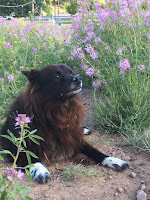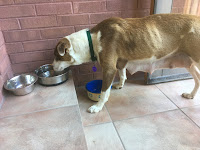
If you've known me for any length of time, you are also familiar with Fritz, my shadow for more than 11 years. The 2 year mark of Fritz' death is just upon us -- May 5. Perhaps it's the effect of sheltering in place for more than 2 months now, or maybe this is just an interminable grieving process, but I have been feeling his loss profoundly. I find that writing about persistently invasive thoughts helps to move through them, so I write about how I lost the best dog in the world.
Fritz joined our family in honor of my daughter's fifth birthday. The rescue group had plucked him from death row as he had been deemed difficult and unadoptable. None of those problems ever surfaced with us, and aside from getting anxious about being left alone, he never caused any issues. He was my steadfast companion as I weathered a divorce and multiple moves. He was up for doing most anything -- as long as he didn't have to get too wet -- and so he went everywhere possible with me.
It was a glorious May Saturday in our corner of the world. Fritz and I had spent the morning at the Nature Center, pulling weeds in the parking lot, airing out our little welcome building and initiating the summer season at our living laboratory.
We came home in the early afternoon only to find our street packed with cars because it was the final day of our town's annual wine festival, and there was a big-tent event across the street. Someone had even parked in my driveway. I was miffed, but it was short-lived as a space on the opposite side of the street opened up.
After a quick lunch, I mingled at the event for a while and then, returned home to do some work. As dusk approached, I realized I needed something from my car, so I wandered across the street to retrieve it. By now, the event was over, but there were still plenty of people milling about, and our street still had plenty of parked cars along it.
As I crossed the street back toward the house, I saw an SUV round the corner and was gunning up the hill. Our street is a well-known cut through to avoid traffic lights along Main Street, so this is a common occurrence. Given my years of advocacy for pedestrians and bicyclists, I often wave at people to slow down. I did so on this occasion, too, only to realize that the SUV was actually a police vehicle. The officer stopped and asked what the problem was.
Meanwhile, Fritz had tired of my delayed return to the house and had nosed open the front door, which I'd obviously left ajar. He was standing in the front yard as I started my conversation with the officer, but thinking that this must be a new friend, he wandered around to the driver's door to officially greet him.
The conversation between the young officer and I was simple and brief. I explained that I thought he was driving pretty fast given conditions. Plenty of pedestrians were still wandering about and in fact, several had stopped to watch the scene unfold. He told me that he was on a call. I remarked that he didn't have his lights on, and he replied that he didn't need his lights on for every call. He accelerated as he finished his retort, just as Fritz decided to return to me.
We needed just one more second...
In another second, Fritz would have been clear of the police car. Instead, the officer's left front tire rolled right over the back end of him. The look on my beloved dog's face and the cry that he made will live with me forever. I remember clearly thinking, "Don't let me lose him like this." I immediately rushed to him, and in his anguish and shock, he bit me, but I just wrapped myself around him to calm him down.

The officer stopped and radioed in the incident. Things get a bit fuzzy for me at this point, but it seems that within minutes the street was full of emergency vehicles. It was chaos. Bystanders were yelling at the officer, asking why he was speeding. EMTs unwrapped me from my dog, but he absolutely panicked as I was removed from him. They threw a fireman's jacket over him, and one EMT took my place and wrapped himself around Fritz to calm him, telling me he had several dogs of his own.
Fritz had done a fair bit of damage to me, and EMTs were tending to my wounds and wanted to get me to the hospital. Anytime they tried to move me further from Fritz, he would again panic, and finally, I told them I could not leave my dog. They treated me as best they could and wrapped both arms, but the wounds were bleeding pretty profusely.
The supervising sergeant was on the scene and asked me a few questions, and then, we made plans to get Fritz to the emergency vet. Given the severity of my bites, the EMTs were wary of just picking him up, so three of them suited up fully in their fire protection gear, and they wrapped a blanket around his head. They decided that the best mode of transport was the vehicle that actually ran over Fritz. So they placed me in the back seat, and then, three of them loaded Fritz in next to me. The seat was hard plastic, and every bump on our 1/2 mile drive jarred Fritz, and he cried. So did I.
The vet met us at the car with a muzzle and a stretcher and carted Fritz off quickly. I was met by the supervising sergeant and an animal control officer as well. They interviewed me, and then, implored me to get to the hospital. The animal control officer offered to drive me. By now, I had some of my wits about me, and I realized that I would need a way home from the hospital. It was getting late so I could not call on friends, so I asked him to just drop me off at home, and I would drive my self. He did.
In the end, I had a dozen puncture wounds and a total of 5 stitches. Given that dog bites are prone to infection, they were reluctant to stitch up more. They loaded me up with painkillers and antibiotics, and I returned home to two very confused cats. The three of us endured a sleepless and distraught night.

The emergency vet had checked in a couple of times that night to let me know that the x-rays revealed a fractured pelvis, but she assured me that he was resting well with the sedatives, and she was optimistic that he might pull through. By the time she called me in the morning she was not as optimistic, and she wanted me to transport him to the largest of our local animal hospitals for their assessment.
The drive between vet hospitals crushed me. The vet had laid him on a soft bed in the back of my Subaru wagon, but he was so desperate to be near me. He would try to crawl to me, and then, whimper in pain. He still had a muzzle on so he couldn't actually yelp.
The assessment at Riverview was quick. We could send him up to Denver to have a specialist try to repair the fracture, but at significant cost. Given that Fritz was 13.5, it was unlikely to be successful. I had to say goodbye.
The techs brought him into the exam room, and set him on the floor next to me and removed his muzzle and left us alone for a little while. He was so relieved to have his muzzle removed. He just laid his head on my lap and whimpered. The vet came in and, with the magic of a couple of injections, ended his pain. That was it. My shadow of 11+ years was gone.
It all seemed so surreal. There are so many "what ifs," but none of that matters. This is one of those instances that changes life so dramatically. All it took was a second.
I miss you so very much, dog dog.




























